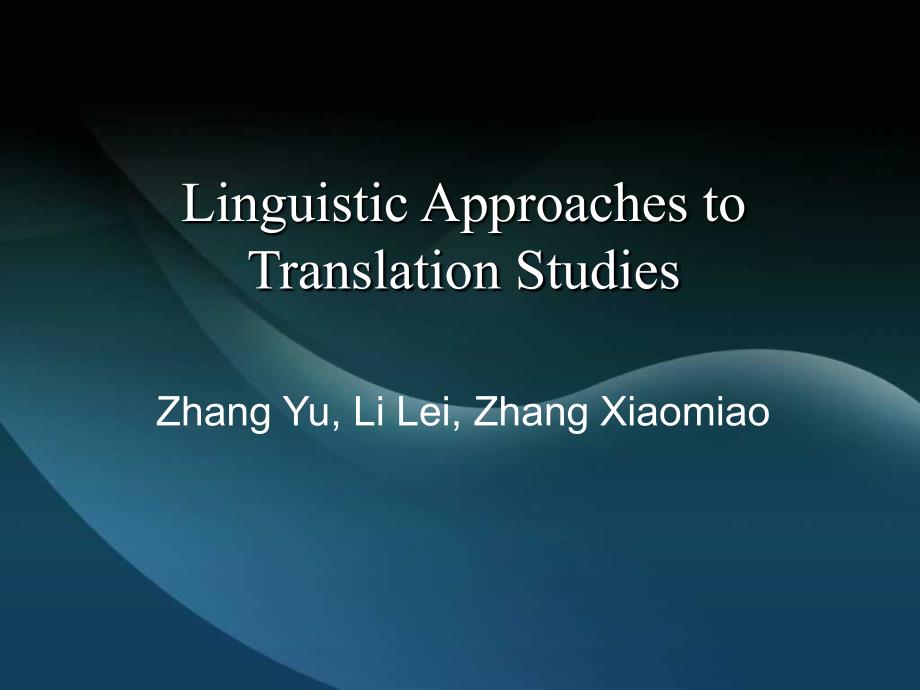 语言学应用于翻译PPT课件
语言学应用于翻译PPT课件



《语言学应用于翻译PPT课件》由会员分享,可在线阅读,更多相关《语言学应用于翻译PPT课件(60页珍藏版)》请在装配图网上搜索。
1、Linguistic Approaches to Translation StudiesZhangYu,LiLei,ZhangXiaomiaoIntroductionAfterthecenturiesofcirculardebatesaroundliteralandfreetranslation,theoreticiansinthe1950sand1960sbegantoattemptmoresystematicanalyzesoftranslation.Thenewdebaterevolvedaroundcertainkeylinguisticissues.Themostprominento
2、ftheseissueswerethoseofmeaningandequivalence.KeyfiguresandtheirtheoriesinthisnewdebateRomanJakobson:thenatureoflinguisticmeaningandequivalenceEugeneNida:formalanddynamicequivalenceandtheprincipleofequivalenceeffectPeterNewmark:semanticandcommunicativetranslationWernerKoller:korrespondenzandquivalenz
3、RomanJakobsonAboutRomanJakobsonInterlingualtranslation:linguisticmeaningandequivalenceAboutRomanJakobson:Roman Osipovich Jakobson(October11,1896-July18,1982)wasaRussianlinguistandliterarytheorist.Asapioneerofthestructuralanalysisoflanguage,whichbecamethedominanttrendoftwentieth-centurylinguistics,Ja
4、kobsonwasamongthemostinfluentiallinguistsofthecentury.InfluencedbytheworkofFerdinanddeSaussure,Jakobsondeveloped,withNikolaiTrubetzkoy,techniquesfortheanalysisofsoundsystemsinlanguageMainworks:On Linguistic Aspects of Translation,Jakobsons Communication ModelRomanJackobsonsthreekindoftranslation:Int
5、ralingualtranslation(语内翻译)Interlingualtranslation(语际翻译)Intersemiotictranslation(符际翻译)HerewefocusonhisinterlingualtranslationInterlingualtranslationInterlingualtranslationreferringtotranslationbetweentwodifferentwrittenlanguages.KeyissuesofInterlingualtranslation:linguisticmeaningandequivalenceLingui
6、sticmeaningHereJackobsonfollowstherelationsetoutbySaussurebetweenthesignifier(能指)andthesignified(所指),therelationshipbetweenthemisarbitrary.E.g.:cheeseTheEnglishwordcheeseistheacousticsignifierwhichdenotestheconceptfoodmadeofpressedcurds(thesignified),althoughthereisnoinherentreasonforwhattobeso.Equi
7、valence(equivalenceinmeaningbetweendifferentlanguages)Jakobsonspoints:Hereisordinarilynofullequivalencebetweencode-units(代码单位之间通常不存在完全的对等)Theproblemofmeaningandequivalencefocusondifferencesinthestructureandterminologyoflanguage.(意义和对等的问题主要在于语言结构和语言用语之间的差异。)Cross-linguisticdifferencescentrearoundobli
8、gatorygrammaticalandlexicalforms,theyoccurat:thelevelofgender,thelevelofaspect,thelevelofsemanticfields(跨语言的差异主要集中在一定的语法词汇形式,体现在性别层面上,形貌层面上和语义领域层面上)Thequestionsofmeaning,equivalenceandtranslatabilitybecameaconstantthemeoftranslationstudiesinthe1960andweretackledbyanewscientificapproachfollowedbyoneo
9、fthemostimportantfiguresintranslationstudies,theAmericanEugeneNida.Eugene A.Nidathe“science”oftranslatingContentIntroductionThenatureofmeaning:advancesinsemanticsandpragmaticsTheinfluenceofChomskyFormalanddynamicequivalenceThediscussiontotranslationtheoriesofNidaIntroductionlToward a Science of Tran
10、slating-(Brill,1964)lThe Theory and Practice of Translation-(Brill,1969,withC.R.Taber)lEugene A.Nida(bornNovember11,1914)hasbeenapioneerinthefieldsoftranslationtheoryandlinguistics.HismostnotableandmostcontroversialcontributiontotranslationtheoryisDynamicEquivalence,alsoknownasFunctionalEquivalence.
11、Thisapproachtotranslationaimstoreproducetheintentionoftheoriginaltextinthetranslation,ratherthanreproducingtheactualwordsoftheoriginal.Thenatureofmeaning:advancesinsemanticsandpragmaticsTheoriginofNidasapproachTheaimofNidasresearchClassificationofmeaningTechniquestodeterminereferentialandemotivemean
12、ingTheoriginofNidasapproachNidasmoresystematicapproachborrowstheoreticalconceptsandterminologybothfromsemanticsandpragmaticsandfromNormChomskysworkonsyntacticstructurewhichformedthetheoryofgenerative-transformationalgrammar.(奈达较具系统的研究方法,是从语用学和语义学的理论概念和术语以及诺姆乔姆斯基的句法结构著作借鉴而来的,这种句法结构形成了转换生成语法理论。)Theaim
13、forNidasresearchfromthesemanticandpragmaticangleCentraltoNidasworkisthemoveawayfromtheoldideathatanorthographicwordhasafixedmeaningandtowardsafunctionaldefinitionofmeaningwhichaword“acquires”meaningthroughitscontextandcanproducevaryingresponsesaccordingtoculture.(奈达的研究旨在摆脱那种认为每个单词都有固定意义的陈腔,提倡对意义进行功能
14、定义,词要通过语境才能“得到”意义,并可依据不同文化产生不同反应。)ClassificationofmeaningMeaningisbrokendowninto:linguisticmeaning(语言意义),referentialmeaning(指称意义),Emotive(orconnotative)meaning(情感或内涵意义).TechniquestodeterminereferentialandemotivemeaningTechniquestodeterminereferentialandemotivemeaningfocusonanalyzingthestructureofwor
15、dsanddifferentiatingsimilarwordsinrelatedlexicalfields.(决定指称意义和情感意义的技巧,主要集中于分析词的结构,以及区分相关词汇领域中的近义词。)Thesetechniquesinclude:1,Hierarchicalstructuring(层级结构法),whichdifferentiatesseriesofwordsaccordingtotheirlevel.以层级来区分词组。(superordinateandhyponyms)2,Componentialanalysis(成分分析),whichseektoidentifyanddisc
16、riminatespecificfeaturesofarangeofrelatedwords.旨在识别和区分一组相关词语的特性。(relationshipterms)3,Semanticstructureanalysis(语义结构分析),whichencouragethetraineetranslatortorealizethatthesenseofavariesandmostparticularityisconditionedbyitscontext.鼓励受训翻译人员意识到一种语义复杂的用语其意思变化多端,最为其语境所制约。(e.g.spirit,bachelor)Theinfluenceo
17、fChomskyIntroductionofChomskysmodelAboutkernelsNidasdevelopmentofthemodelNidasthree-stagesystemoftranslationIntroductionNidaincorporateskeyfeaturesofChomskysmodelintohis“science”oftranslation.Chomskysgenerative-transformationalmodelanalyzessentencesintoaseriesofrelatedlevelsgovernedbyrules.把句子分析为一系列
18、受规则制约的相关层级。转换生成语法的规则为:一部分生成语法的核心句,即那些初级的基本的语句;一部分则可通过转换规则从核心句转换成无数的派生句。e.g.1,Themanwhokickedtheballscoredthegoalthatwonthegame.2,Themanwhohadssuperperformancescoredthegoalthatmadehisteamthewinner.虽然这两句的表层结构不同,但其深层结构的语法关系始终是一致的:Themanscoredthegoal.AboutkernelsKernels“arethebasicstructuralelementsouto
19、fwhichlanguagebuildsitselaboratesurfacestructures”.核心句是“用来构成语言复杂表层结构的基本结构成分”。KernelsaretobeobtainedfromtheSTsurfacestructurebyareductiveprocessofback-transformation.核心句乃从原语文本的表层结构通过逆向转换的还原过程变换而来的。Kernelsarethelevelatwhichthemessageistransferredintothereceptorlanguagebeforebeingtransformedintothesurf
20、acestructureinthreestages:“literaltransfer”,“minimaltransfer”and“literarytransfer”.核心句是讯息被转移至接受语时的层次,而且尚未经过三个转换阶段“字面转移”,“低度转移”,“书面转移”。P.41NidasdevelopmentofthemodelNidaseesthatitprovidesthetranslatorwithatechniquefordecodingtheSTandaprocedureforencodingtheTT,althoughhereservesChomskysmodelwhenanalyz
21、ingtheST.Thus,thesurfacestructureoftheSTisanalyzedintothebasicelementsofthedeepstructure;thesearetransferredinthetranslationprocessandthenrestructuredsemanticallyandstylisticallyintothesurfacestructureofTT.(奈达认为这种模式为译者提供对原语文本进行解码的技巧,以及对目的语文本进行编码程序,不过在分析原语文本时,奈达却将乔姆斯基的模式倒序进行。)A(sourcelanguage)B(recep
22、torlanguage)原语接受语(analysis)分析(restructuring)重构转移X(transfer)YNidasthree-stagesystemoftranslationFormalanddynamicequivalenceandtheprincipleofequivalenteffectTypesofequivalenceFormalequivalenceanddynamicequivalencesupplementFourbasicrequirementsoftranslationTypesofequivalence“Twobasicorientations”or“ty
23、pesofequivalence”:(1)Formalequivalence;(形式对等)(2)Dynamicequivalence.(动态对等)FormalequivalenceanddynamicequivalenceFormalequivalenceFormalequivalencefocusesattentiononthemessageitself,inbothformandcontentOneisconcernedthatthemessageinthereceptorlanguageshouldmatchascloselyaspossiblethedifferentelementsi
24、nthesourcelanguage.形式对等强调要注意讯息本身的形式和内容,其中要关注的是接受语中的讯息应与原语中的不同成分尽可能的保持一致。Mosttypicalofthiskindoftranslationare“glosstranslation”,withacloseapproximationtoSTstructure,oftenwithscholarlyfootnotes,allowingthestudenttogaincloseaccesstothelanguageandcustomsofthesourceculture.最典型的类似翻译是“释译”,最贴近原文结构,通常附以注释让学
25、生对该原语文化的语言和习俗加深理解。DynamicequivalenceisbasedonwhatNidacalls“theprincipleofequivalenteffect”,where“therelationshipbetweenreceptorandmessageshouldbesubstantiallythesameasthatwhichexistedbetweentheoriginalreceptorandthemessage”.动态对等是基于奈达的“对等效应原则”,要求“接受者和讯息之间的关系应与原来是接受者和讯息间所存在的关系保持相当程度的一致”。supplementDoyo
26、useeanygreeninmyeye?形式对等:你从我的眼睛里看到绿色吗?动态对等:你以为我是好欺负的吗?奈达有关翻译的定义指明,翻译不仅是词汇意义上的对等,还包括语义、风格和文体的对等,翻译传达的信息既有表层词汇信息,也有深层的文化信息。“动态对等”中的对等包括四个方面:1.词汇对等;2.句法对等;3.篇章对等;4.文体对等。在这四个方面中,奈达认为,”correspondenceinmeaningmusthavepriorityovercorrespondenceinstyle”(意义是最重要的,形式其次)(郭建中,2000,P67)。形式很可能掩藏源语的文化意义,并阻碍文化交流。因此,
27、在文学翻译中,根据奈达的理论,译者应以动态对等的四个方面,作为翻译的原则,准确地在目的语中再现源语的文化内涵。FourbasicrequirementsoftranslationMakingsense(言之成理);Conveyingthespiritandmanneroftheoriginal(传达原文精神风貌);Havinganatureandeasyformofexpression(表达自然流畅);Producingasimilarresponse(产生共鸣).ThediscussiontotranslationtheoriesofNidaAdvantages:Thekeyroleplay
28、edbyNidaistopointtheroadawayfromstrictword-for-wordequivalence.奈达所以的关键作用在于为翻译摆脱词与词之间的严格对等指明了道路。Hisproductionoftheconceptsofformalanddynamicequivalencewerecrucialinintroducingareceptor-basedorientationtotranslationtheory.他所提出的形式对等和动态对等概念,为翻译理论引入一种以接受者为导向(或基于读者)的概念具有重要影响。Nidawentalongwaytoproducingasy
29、stematicanalyticalprocedurefortranslatorsworkingwithallkindsoftextandhefactoredintothetranslationequationthereceiversoftheTTandtheirculturalexpectations.他经过长期研究探索出一套为翻译人员制定各种语篇的系统系分析程序,并且把目的语文本的接受者和他们的文化期许也纳入翻译程序的考虑因素。CriticismEquivalenceisstilloverlyconcernedwiththewordlevel.(byLefevere)对等仍然过分关注词汇层
30、。Equivalenteffectorresponsetobeimpossible.(byvandenBroeckandLarose)对等效应和反应是不可能的。The“implausibility”ofequivalentresponse.对等反应的不可行性。Theclosestnaturalequivalentmaystandinacontradictoryrelationwithdynamicequivalence.最贴切的对等可能与动态对等有所矛盾。Culturalreferences.文化指称问题。(byQianHu)PeterNewmarkAboutPeterNewmarkDefin
31、itionofCommunicationtranslationandSemantictranslationMaindifferencebetweenNidaandNewmarkComparisonofNewmarkssemanticandcommunicativetranslationDiscussionofNewmarkAboutPeterNewmarkPeterNewmark(19162011),wasanEnglishprofessoroftranslationattheUniversityofSurrey.Mainworks:Approaches to translation(1981
32、)A Textbook of Translation(1988),Paragraphs on Translation(1989),About Translation(1991)Maincontribution:heintroducestwokindsoftranslationmethodswhicharesemantictranslation(语义翻译)andcommunicativetranslation(交际翻译)DefinitionofCommunicationtranslationandSemantictranslation:Communicativetranslation:inwhi
33、ch“thetranslatorattemptstoproducethesameeffectontheTLreadersaswasproducedbytheoriginalontheSLreaders”(1981/1988:22).(resemblesNidasdyanmicequivalence)交际翻译试图使读者阅读译文所产生的效果尽可能地接近原语读者阅读原文所产生的效果。Semantictranslation:attempttorender,ascloselyasthesemanticandsyntacticstructuresofthesecondlanguageallow,theex
34、actcontextualmeaningtotheoriginal.(resemblestoNidasformalequivalence)语义翻译试图在合乎第二语言的语义和句法结构下,将原文的准确语境意义尽可能贴切地译出。MaindifferencebetweenNidaandNewmark:NewmarkdidnotagreewithNidasfullprincipleofequivalenteffect,sincethateffectisinoperantifthetextisoutofTLspaceandtime(1981:69)Forexample:Thetranslatorcanno
35、tpossiblehopeorexpecttoproducethesameeffectontheTTreaderastheSThadonlistenersinancientGreecewhencomestothetranslationofHomer.ComparisonofNewmarkssemanticandcommunicativetranslation:Communicativetranslation,isconcernedmainlywiththereaders,usuallyinthecontextofalanguageandculturalvariety,whilesemantic
36、translationisconcernedwiththeauthorusuallyasanindividual,andoftenincontradistinctionbothtohiscultureandtothenormsofhislanguage.FormoredetailsPleaseseePage45.Forexample:Wetpaint!semantictranslation(语义翻译):湿油漆!communicativetranslation(交际翻译):油漆未干,请勿触摸Newmarkstatesclearlythereisnopurelysemantictranslatio
37、norpurelycommunicativetranslationintranslationpractice,andonlythroughacombinationofthetwomethodscanatranslationbebothaccurateinmeaningandacceptabletothetargetlanguagereader.However,ifthereisaconflictbetweenthetwoformsoftranslation,thencommunicativetranslationshouldwinout.DiscussionofNewmarkNewmarkst
38、ermssemantictranslationandcommunicativetranslationhaveoftenbeenquotedintheliteratureoftranslationtheory,buttheyhavereceivedfarlessdiscussionthanNidasformalanddynamicequivalend.Newmarkhasbeencriticizedforhisstrongprescriptivism.ThelargenumberofexamplesinNewmarksworkprovideampleguidanceandadviceforthe
39、traineeandmanyofthequestionshetacklesareofimportantpracticalrelevancetotranslation.Werner Werner KollerKollerWernerKollerCorrespondenceandEquivalenceContentBackgroundDifferencesbetweencorrespondenceandequivalenceFivedifferenttypesofequivalenceHowtoaidthetranslatorandtheroleofthetranslationtheoryKoll
40、erschecklistfortranslationallyrelevanttextanalysisSummaryBackgroundNidasmovetowardsascienceoftranslationhasprovedtobeespeciallyinfluentialinGermany.ImportantworkonequivalencewascarriedoutbyWernerKoller.KollersResearch into the science of translationexaminesmorecloselytheconceptofequivalenceanditslin
41、kedtermcorrespondence.DifferencesbetweenthetwotermsCorrespondencefallswithinthefieldofcontrastivelinguistics,whichcomparestwolanguagesystemsanddescribescontrastivelydifferencesandsimilarities.ItsparametersarethoseofSaussureslangue(Saussure1916/83).对应属于对比语言学领域,用来比较两种语言系统,并对比描述两者的异同。其参数采用了索绪尔的langue语言
42、。EquivalencerelatestoequivalentitemsinspecificST-TTpairsandcontexts.TheparameteristhatofSaussuresparole.对等则指切合个别原语文本和目的语文本配对和语境的对等项目。其参数采用了索绪尔的parole言语。Kollerpointsoutthat,whileknowledgeofcorrespondenceisindicativeofcompetenceintheforeignlanguage,itisknowledgeandabilityinequivalencesthatareindicativ
43、eofcompetenceintranslation.科勒指出,掌握对应体现外语能力,而掌握并能够使用对等则体现翻译能力。FivedifferenttypesofequivalenceDenotative equivalence isrelatedtoequivalenceoftheextralinguisticcontentofatext.Otherliterature,saysKoller,callsthiscontentinvariance.外延对等外延对等,指与一个语篇的语言外部内容对等。科勒指出,其他文献称之为“内容恒定性”。Connotative equivalence isrel
44、atedtorelatedtothelexicalchoices,especiallybetweennear-synonyms.Kollerseesthistypeofequivalenceaselsewherebeingreferredtoasstylisticequivalence.内涵对等内涵对等,指词汇选择,尤其是近义词之间的选择。科勒指其他文献称为“文体对等”。Text-normativeequivalenceisrelatedtotexttypes,withdifferentkindsoftextsbehavingindifferentways.语篇规约对等语篇规约对等与语篇类型有
45、关,不同的语篇对等方式不同。Pragmatic equivalence,orcommunicativeequivalence,isorientedtowardsthereceiverofthetextormessage.ThisisNidasdynamicequivalence.语用对等语用对等或“交际对等”,强调语篇或信息接受者导向,相当于奈达的“动态对等”。Formal equivalence,whichisrelatedtotheformandaestheticsofthetext,includeswordplaysandtheindividualstylisticfeaturesoft
46、heST.ItiselsewherereferredtoasexpressiveequivalenceandisnottobeconfusedwithNidasterm.形式对等形式对等,与语篇的形式和美感有关,包括原语文本中的文字游戏和文体特色,其他文献或称为“表达对等”,切勿与奈达的同类术语混淆。Table3.3Characteristicsofresearchfocifordifferenttypes(followingKoller1979:187-91)SeePage48HowtoaidthetranslatorandtheroleofthetranslationtheoryWithe
47、verytextasawhole,andalsowitheverysegmentoftext,thetranslatorwhoconsciouslymakessuchachoicemustsetupahierarchy of values to be preserved in translation;fromthishesiccanderiveahierarchyofequivalencerequirementsforthetextorsegmentinquestion.Thisinturnmustbeprecededbyatranslationally relevant text analy
48、sis.Itisanurgenttaskoftranslationtheory-andoneonwhichnomorethansomepreliminaryworkhassofarbeendone-todevelopamethodologyandconceptualapparatusforthiskindoftextanalysis,andtobringtogetherandsystematizesuchanalyzesintermsoftranslationallyrelevanttypologiesoftextualfeatures.(Koller1979b/89:104;emphasis
49、isKollers)翻译者如以每个语篇作为整体,甚或于语篇的每一片段刻意选择,必须设立一个价值层级架构,并在翻译中予以保留;翻译者根据这些价值层级架构可推导出所要翻译得语篇或片段的对等要求层级架构,并必须先行通过有关翻译得语篇分析。翻译理论的一项迫切任务仅仅做了这些初步工作是要研究出类似的语篇分析方法和理念结构,再按照语篇特征的相关翻译类型学融会贯通,并使之系统化。Kollerschecklistfortranslationallyrelevanttextanalysisundertheheadingsof:languagefunction;contentcharacteristics;lan
50、guage-stylisticcharacteristics;formal-aestheticcharacteristics;pragmaticcharacteristics.科勒提出下列标题作为与翻译相关语篇分析的清单语言功能;内容特点;语言文体特点;形式美感特点;语用特点。SummaryThischapterhasexaminedimportantquestionsoftranslationraisedbylinguisticsinthe1950sand1960s.Thekeytermsaremeaningandequivalence,discussedbyRomanJackobsonin
51、1959andcruciallydevelopedbyNida,whosebooksanalyzemeaningsystematicallyandproposethatatranslationshouldaimforequivalenteffect.Despitesubsequentquestioningofthefeasibilityofthatgoal,Nidasgreatachievementistohavedrawntranslationtheoryawayfromthestagnantliteralvs.freedebateandintothemodernera.Hisconcept
52、sofformalanddynamicequivalenceplacethereceiverinthecentreoftheequationandhaveexertedhugeinfluenceoversubsequenttheoreticians,especiallyinGermany.本章探讨了20世纪50年代和60年代由语言学引起的翻译中的重要问题。主要术语是意义和对等,这些术语雅各布森1959年已有讨论,再由奈达发扬光大,其论著系统地分析了意义并提出翻译应注重对等效应。尽管后来人们对此目标的可行性有所质疑,奈达的伟大成就在于将翻译理论从停滞不前的“直译与意译”争论中摆脱出来,并将之带入了一个新时代。他的形式对等和动态对等概念把接受者放在程序的中心位置,对随后的理论家,尤其是德国的理论家影响至巨。Thankyou!
- 温馨提示:
1: 本站所有资源如无特殊说明,都需要本地电脑安装OFFICE2007和PDF阅读器。图纸软件为CAD,CAXA,PROE,UG,SolidWorks等.压缩文件请下载最新的WinRAR软件解压。
2: 本站的文档不包含任何第三方提供的附件图纸等,如果需要附件,请联系上传者。文件的所有权益归上传用户所有。
3.本站RAR压缩包中若带图纸,网页内容里面会有图纸预览,若没有图纸预览就没有图纸。
4. 未经权益所有人同意不得将文件中的内容挪作商业或盈利用途。
5. 装配图网仅提供信息存储空间,仅对用户上传内容的表现方式做保护处理,对用户上传分享的文档内容本身不做任何修改或编辑,并不能对任何下载内容负责。
6. 下载文件中如有侵权或不适当内容,请与我们联系,我们立即纠正。
7. 本站不保证下载资源的准确性、安全性和完整性, 同时也不承担用户因使用这些下载资源对自己和他人造成任何形式的伤害或损失。
